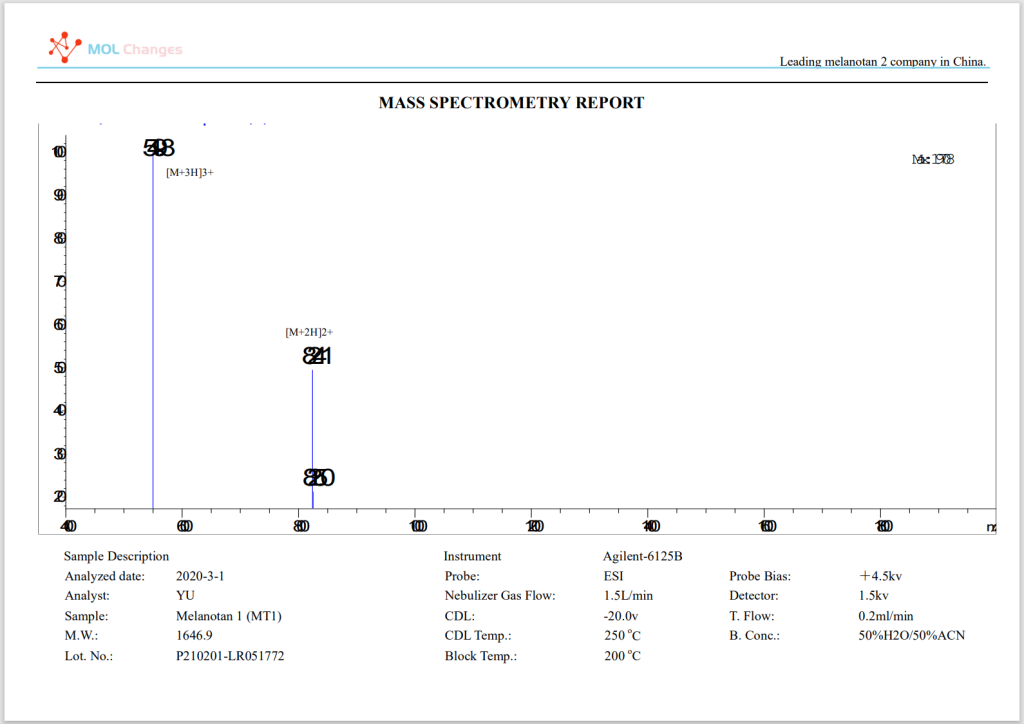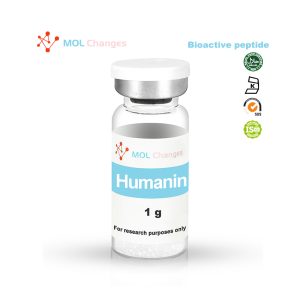
製品情報ナビゲーション
Melanotan-I Structure
- シーケンス:Ser-Tyr-Ser-Nle-Glu-His-D-Phe-Arg-Trp-Gly-Lys-Pro-Val
- CAS番号C78H111N21O19
- 分子式:1646.874 g/mol
- 分子量: 75921-69-6
What is Melanotan-I?
Melanotan 1 is a synthetic analog of alpha-melanocyte stimulating hormone. It is used clinically in Europe to prevent sun-related skin damage (i.e., phototoxicity) in patients with erythropoietic protoporphyria. Although Melanotan 1 was originally developed as a sunless tanning agent, it has been found to have a variety of physiological effects on blood pressure, feeding behavior, and central nervous system function. The peptide is in Phase 3 clinical trials for the treatment of polymorphic sun rash and Phase 2 clinical trials for the treatment of actinic keratosis, a specific type of sun-induced skin damage, and its more serious counterpart, squamous cell carcinoma.
Melanotan-I Effects
Melanotan 1 originally designed for sunless tanning
MT-1 has been studied in Phase I clinical trials for its effect on human tanning following exposure to UV radiation. The study showed that subjects taking MT-1 were 75% more likely to tan and 47% less likely to burn. Compared to the control group, subjects taking Melanotan 1 needed to reduce their UV exposure by 50% to achieve an equivalent tanning effect. They also maintained their tan for three weeks longer compared to those exposed only to UV light. The scientists concluded that melanotan 1 could be used to promote tanning in high UV environments to prevent the long-term effects of sunburn and UV skin damage. This is particularly useful for individuals with tanning skin types (called Type I and Type II based on the Fitzpatrick scale).
Studies on individuals with the variant MC1 receptor have shown that they are less likely to tan than the general population. Administration of melanotan 1 in such cases has been shown to significantly increase melanin density and tanning efficacy, helping to protect individuals who tan poorly and are most in need of photoprotection. These individuals derive limited benefit from sunscreen, and sun exposure must be heavily restricted to prevent skin cancer. This study could open up avenues for better UV protection and a significant reduction in the incidence of skin cancer.
There is also interest in using Melanotan 1 to treat vitiligo. A small phase 1 trial showed that combining melanotan 1 with UVB phototherapy stimulated melanin production and the proliferation of melanin-producing melanocytes. Nearly half of the treated patients showed improved and faster pigmentation of vitiligo lesions. Studies have shown that combining Melanotan 1 treatment with existing vitiligo treatments can have a synergistic effect and improve aesthetic outcomes in a shorter period of time. If vitiligo treatment is successful, melanotan 1 may be able to be used to treat, for example, hypopigmented scars.
Actinic keratosis, also known as solar keratosis, is a crusty, scaly growth of the skin caused by overexposure to ultraviolet light. It is considered a precancerous condition that, if left untreated, will eventually lead to squamous cell carcinoma (a type of skin cancer). There are more than 400,000 cases each year. Although a dermatologist or surgeon can remove obvious lesions, the vast majority of them are small, invisible or even untouchable.Melanotan 1 is being studied as a possible first-line drug to treat these invisible lesions and prevent them from progressing to full-blown skin cancer.
Melanotan-1 Research and Blood Pressure
Studies in hypertensive mice have shown that melanotan 1 prevents high blood pressure without affecting animals with normal blood pressure. This is important because current antihypertensive drugs can cause low blood pressure, which can lead to loss of consciousness, stroke, and heart attack. Such side effects of antihypertensive drugs are more common in the elderly, in part because of their physiological instability.Melanotan 1 has the ability to modulate hypertension without causing significant hypotension, making it a perfect candidate for exploring further drug development.
Cognitive decline, Alzheimer’s disease and Melanotan 1
Studies in transgenic mice have shown that melanotan 1 protects the brain from damage that leads to cognitive decline and Alzheimer’s disease. The study, which used a mouse model of moderate Alzheimer’s disease (AD), showed that Melanotan 1, even in very small doses, reduced levels of amyloid plaques in the brain, protected neurons from death, and improved clinical measures of cognitive function as well as laboratory measures of synaptic transmission. In the same study, blocking the action of Melanotan 1 on the MC4 receptor prevented all of the peptide’s beneficial effects.
Other studies have also explored the benefits of Melanotan 1 on MC4 receptor action. Studies, also in mice, have shown that MC4 receptor stimulation promotes neurogenesis and leads to cognitive recovery in AD patients. This is one of the few studies to show an improvement rather than simply a slowing of decline, and daily administration of MT-1 reduced levels of all AD-related biomarkers, suggesting that the peptide actually acts through multiple pathophysiologic pathways.
The MC4 receptor is the only melanocortin receptor known to be expressed on astrocytes, which protect and nourish neurons. Studies in rats have shown that melanotan 1 improves astrocyte function by increasing levels of brain-derived neurotrophic factor (BDNF), which is essential for protecting synaptic stability and neurogenesis.
Melanotan 1 and functional recovery after stroke
It is not just biomarkers in AD that improve after MT-1 treatment. Studies in a gerbil model of stroke lasting ten minutes have shown that treatment with a nanomolar dose of Melanotan 2 reduces brain damage, including neuronal death, and improves recovery of learning and memory. What is really exciting is that these effects were achieved even when Melanotan 1 was administered nine hours after the stroke. It is believed that MT-1 activates repair mechanisms that improve synaptic plasticity and promote lasting functional recovery by allowing the brain to shift learning and memory to healthier regions. Key to this process appears to be the expression of the Zif268 gene, which is overexpressed in animals given melanotan-1. The same gene is also overexpressed in a model of Alzheimer’s disease that shows improved cognitive performance.
Melanotan 1 affects the heart and circulation
Studies in rats with heart disease have shown that melanotan 1 and other melanocortins help reduce damage and improve circulatory parameters. Administration of MT-1 during cardiopulmonary resuscitation and in combination with epinephrine helped restore baseline arterial pressure and heart rate, reverse metabolic acidosis, reduce markers of inflammation, and improve the expression of genes associated with cardiac function. Overall, the therapy improved survival by 81%, a dramatic increase that may make Melanotan 1 or similar melanocortins the backbone of emergency advanced cardiac life support.
Melanotan 1 Research and Neuroinflammatory Diseases
Research on Melanotan 1 has shown that the MC1 receptor is responsible for skin and hair pigmentation. For a long time, it was thought that this was the sole function of the receptor. However, recent studies in mice have shown that this receptor plays a role in mediating inflammation in the central nervous system. For example, in multiple sclerosis, helper T cells cause neuronal myelin deficiency, which in turn leads to neuronal dysfunction and even death. In mice, administration of Melanotan 1 interferes with this process and prevents loss of myelin, thereby preventing neuronal damage. In fact, administration of MT-1 to these mice improved myelin recovery and helped to re-establish neuronal signaling.
Similar effects to those described above have been observed in a mouse model of uveitis, an inflammatory disease of the eye that can lead to pain and loss of vision. Current treatments have a range of side effects, so scientists are constantly searching for alternatives to steroids and immunosuppressive drugs. alpha-MSH inhibits T-cell function, a property mediated through the MC4 receptor and therefore mimicked by MT-1. Surprisingly, direct topical administration of MC4 receptor agonists to the eye is as effective as systemic administration. This route of administration helps to eliminate systemic side effects.
Melanotan 1 in fat loss trials
Melanotan 1 acts on a variety of melanocortin receptors, including the MC5 receptor.Stimulation of the MC5R promotes muscle oxidation of fatty acids and converts adipocytes from fat storage to fat burning. These findings in mice also suggest that fat burning induced by melanocortin stimulation is complex, involving multiple receptors and physiological pathways.
参考文献
- “Effects of a Superpotent Melanotropic Peptide in Combination With Solar UV Radiation on Tanning of the Skin in Human Volunteers | Dermatology | JAMA Dermatology | JAMA Network.”
- “Effect of MELANOTAN, [Nle(4), D-Phe(7)]-alpha-MSH, on melanin synthesis in humans with MC1R variant alleles. – PubMed – NCBI.” [Online]. Available: https://www.ncbi.nlm.nih.gov/pubmed/16293341. [Accessed: 24-Jun-2019].
- “Afamelanotide and narrowband UV-B phototherapy for the treatment of vitiligo: a randomized multicenter trial.” [Online]. Available: https://reference.medscape.com/medline/abstract/25230094. [Accessed: 24-Jun-2019].
- “Advances in Vitiligo: An Update on Medical and Surgical Treatments.” [Online]. Available: https://reference.medscape.com/medline/abstract/28210378. [Accessed: 24-Jun-2019].
- “α-MSH analogue attenuates blood pressure elevation in DOCA-salt hypertensive mice. – PubMed – NCBI.” [Online]. Available: https://www.ncbi.nlm.nih.gov/pubmed/23977363. [Accessed: 24-Jun-2019].
- “Melanocortins protect against brain damage and counteract cognitive decline in a transgenic mouse model of moderate Alzheimer׳s disease. – PubMed – NCBI.” [Online]. Available: https://www.ncbi.nlm.nih.gov/pubmed/25034807. [Accessed: 24-https://www.ncbi.nlm.nih.gov/pubmed/26003413
- “NDP-α-MSH induces intense neurogenesis and cognitive recovery in Alzheimer transgenic mice through activation of melanocortin MC4 receptors. – PubMed – NCBI.” [Online]. Available:
- “Melanocortins protect against progression of Alzheimer’s disease in triple-transgenic mice by targeting multiple pathophysiological pathways. – PubMed – NCBI.” [Online]. Available: https://www.ncbi.nlm.nih.gov/pubmed/24094579. [Accessed: 24-Jun-2019].
- “Melanocortin 4 receptor activates ERK-cFos pathway to increase brain-derived neurotrophic factor expression in rat astrocytes and hypothalamus. – PubMed – NCBI.” [Online]. Available: https://www.ncbi.nlm.nih.gov/pubmed/25892444. [Accessed: 24-Jun-2019].
- “Functional recovery after delayed treatment of ischemic stroke with melanocortins is associated with overexpression of the activity-dependent gene … – PubMed – NCBI.” [Online]. Available: https://www.ncbi.nlm.nih.gov/pubmed/19345727. [Accessed: 24-Jun-2019].
- “Protective effects of the melanocortin analog NDP-α-MSH in rats undergoing cardiac arrest. – PubMed – NCBI.” [Online]. Available: https://www.ncbi.nlm.nih.gov/pubmed/25446929. [Accessed: 24-Jun-2019].
- “Melanocortin-1 receptor activation is neuroprotective in mouse models of neuroinflammatory disease. – PubMed – NCBI.” [Online]. Available: https://www.ncbi.nlm.nih.gov/pubmed/27797962. [Accessed: 24-Jun-2019].
- “Immunosuppressive activity of a novel peptide analog of α-melanocyte stimulating hormone (α-MSH) in experimental autoimmune uveitis. – PubMed – NCBI.” [Online]. Available: https://www.ncbi.nlm.nih.gov/pubmed/21640392. [Accessed: 24-Jun-2019].
- “Peripheral effect of alpha-melanocyte-stimulating hormone on fatty acid oxidation in skeletal muscle. – PubMed – NCBI.” [Online]. Available: https://www.ncbi.nlm.nih.gov/pubmed/17127674. [Accessed: 24-Jun-2019].
- “Characterization of murine melanocortin receptors mediating adipocyte lipolysis and examination of signalling pathways involved. – PubMed – NCBI.” [Online]. Available: https://www.ncbi.nlm.nih.gov/pubmed/21616121. [Accessed: 24-Jun-2019].
本ウェブサイトで提供されるすべての記事および製品情報は、情報提供および教育目的のみのものです。
この医師/科学者は、理由の如何を問わず、本製品の購入、販売、使用を支持または推奨するものではありません。商船三井チェンジズは、この医師とは、黙示的か否かを問わず、いかなる提携関係も関係もありません。この医師を引用する目的は、このペプチドを研究している科学者による徹底的な研究開発の成果を認め、賞賛することにあります。
HPLC試験報告書

MSテストレポート

メーカー情報
- Melanotan-I is manufactured by MOL Changes factory.
- Melanotan-I supplier MOL Changes.
- 最大許容生産量:100000本。
- 含有量基準:ネットペプチド。
- 純度:全製品で98%以上。
- カスタマイズ1mg-1g サイズのカスタマイズは受諾可能である








